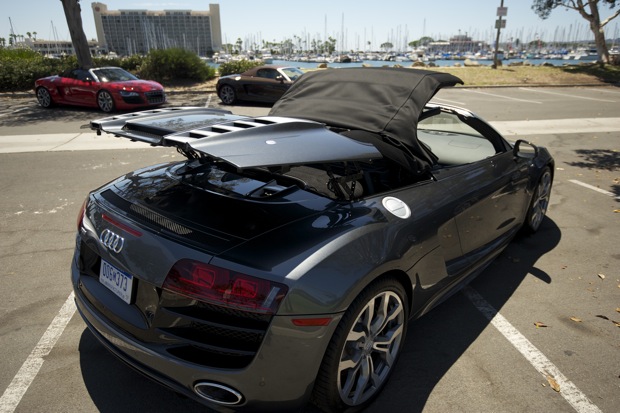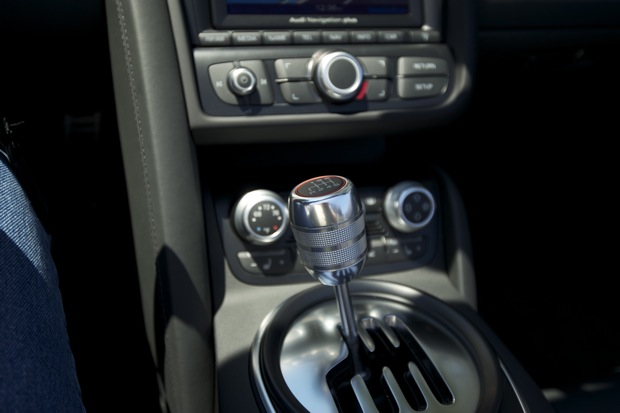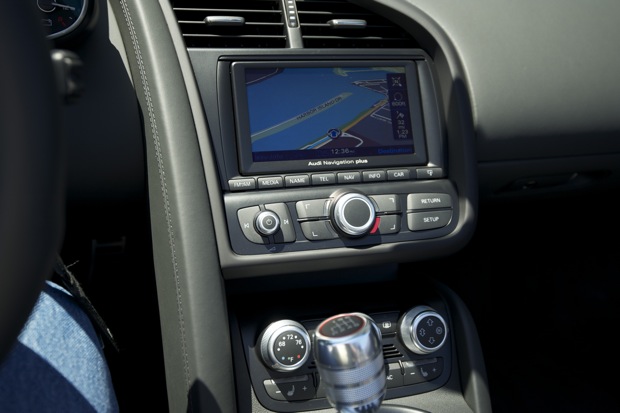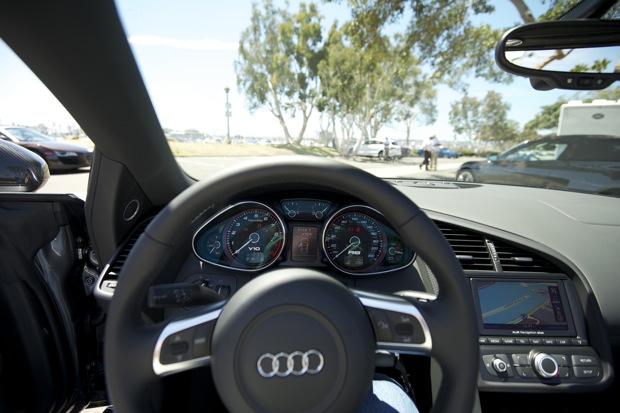
When you think of a supercar, speed and power are usually the things that jump to your mind — not gadgetry. Keeping that in mind, when I was invited to drive Audi’s new R8 Spyder, I jumped at the chance. It wasn’t until later that I started looking into the vehicle and realized that while the R8 is a supercar, it’s a special breed of supercar that uses technology to allow the driver to choose between high performance and touring.
Now a word before I continue: I’m not a supercar expert. Don’t read this expecting to hear about weight ratios, horsepower numbers, or cold statistics. Other sites have covered those to death, and all of that information is of course available directly from Audi. This writeup is about how it feels to drive and the technology that makes it feel that way. Furthermore, you’re going to have to excuse a certain lack of objectivity. It’s not like I can compare the R8 to all the other supercars I’ve driven (that would be none) — think of this as an ode to an amazing piece of technology.
One thing to get out right away; this car costs as much as a small house, and in some places, a large house. The base model costs $161,000 and rapidly goes up as you start adding options. Want a six-speed R-tronic automatic transmission (you don’t, but it is available)? That’s going to cost you an extra $10,000. Audi actually has their own interior customization shop, so you can get any combination of interiors, and paint colors, even down to changing the color of the thread used in the leather seats and accents on the dash. But more importantly, what is it like to drive?

Like most men, I like to drive fast. I’m generally a conservative driver when my wife and son are in the car, but there is a certain joy in going up a mountain road and making your car work a bit. This is where the R8 Spyder humbled me. When you drive a normal car and decide to push things a bit, you know where the edge is. Maybe you feel the rear end slip a little, or maybe you just don’t have enough power to go up that hill as fast you like. For whatever reason, you know that you’ve hit the limitation of the car, and that’s it – you stay below that point and drive safely. I never reached that point in the R8 Spyder, but of course I’m a guy that typically writes about USB drives.
Driving on the freeway is an odd mix between the desire to go extremely fast, and that concern in the back of your mind that you’re going to accidentally go past a highway patrol car at 100 mph. Audi made it perfectly clear that I was more then welcome to drive the car as I saw fit, but any tickets would be my own responsibility. As such, I really didn’t wind it up until I was in the hills above San Diego. I have to say, the roads were absolutely brilliant. Audi of course planned it that way, and had pre-programmed our route into the car’s GPS system. The GPS is in fact the same as what you would find in the Lamborghini Gallardo. The GPS is part of Audi’s MMI (Multimedia Interface) system, which integrates the stereo (more on that later), the aforementioned GPS, all the trip computer functionality, and the climate control. Essentially, everything that is there to enhance the driver experience.

In fact, let’s talk about the interior for a bit. The car I drove was grey with a black leather interior. Keep in mind, in sunny San Diego, it was 90 degrees that day, and the car was sitting with the top down in the direct sun. Recipe for disaster, right? No, apparently Audi colors the interior using a special pigment that makes it resistant to heating up from direct sunlight. This special pigment actually controls the temperature of the seats, and doesn’t allow the leather to exceed 68 degrees, no matter how much sun they receive. Of course, the seats are heated for the wintertime, but during the summer the Nappa leather seats stay comfortable no matter what. There’s also just a sense of quality about the interior, which you should probably expect for a couple hundred thousand dollars. Even from a sense of texture, Audi delivers an incredible experience. The gear shift knob is milled from a single piece of aluminum, the leather wrapped steering wheel has subtle ridges that guide your finders to the ideal 2:00 and 10:00 positions, and while plastic is used, it is use sparingly rather then as the primary material.
The absolute best part of driving the R8 Spyder would have to be that engine exhaust note. Supercars are designed to be seen, heard, and felt when you are driving at speed, and the Audi does not disappoint. To be honest, every time I saw an overpass, tunnel or other echo worthy location coming up I’d drop down a gear, and hammer the engine just so I could hear that beautiful exhaust note. With this roof down, it’s an experience not to be missed. The roof on the R8 is acoustically insulated, so with the roof up it was much quieter. You could however leave the back window down for “ventilation” purposes. I think Audi put that window in just so you could hear the exhaust better with the roof up. With the window up the interior was quiet enough to compare with a standard street car.

The R8 Spyder has a split personality in many ways. If you disable the traction control and set the suspension to sport, you get a much firmer ride in a car that’s very responsive around the corners (like it’s on rails, really), much like you’d expect in a car of this type. But if you switch the traction control on, and set the suspension to comfort, it’s almost docile. Sure, you still have an incredible amount of torque to play with, but the car settles down to the point you could use it as a daily driver. The suspension feel adjusts using a magnetically charged fluid that changes the ride depending on the mode the driver selects. This makes it incredibly easy to change the performance profile without needing to take the car to a shop to have the shocks adjusted.
The technology included in the R8 is quite impressive. I mentioned the GPS system previously, but the best way to look at it as part of the whole system. The R8 Spyder comes standard with a 12 speaker, 465 watt, Bang & Olufsen sound system. The MMI system also plugs straight into your iPhone or iPod, and you can scroll through your music from the steering wheel using the control stick mounted controls. It automatically turns the stereo down when you get a phone call, or if the GPS needs to give you driving directions. Audi also included built in Bluetooth for pairing your phone, which allows you to use one of the new innovations in the R8 – seat-belt mounted microphones. Audi came up with the rather brilliant idea of including microphones built into the seat-belt that activate when you make a phone call. The best part? The noise reduction technology in the car makes it possible to carry on a conversation at highway speeds with the top down, and the person you’re talking to won’t be able to tell the difference. The R8 has a built-in back up camera, as well as sensors built into the front and rear bumpers that provide audio feedback when you get near an object while parking.

Despite all the technology, the amazing body lines, the high tech dyes used in the leather seats, the best thing about the Audi R8 Spyder is driving it down the freeway at [redacted]mph, with the wind in your hair and a huge grin on your face. Driving a car of this class is an experience that should not be missed, but is out of the reach of most mere mortals like myself. If I had the resources would I buy one? Hell yes. Sure, it’s not practical (the storage space under the hood is minimal at best) but that’s not what cars like this are about. It’s about the visceral feeling of the engine note, the feeling of the road through the steering wheel, driving through a shaded canyon with the top down and going around corners at speeds that push your ability as a driver, and loving every moment of it.